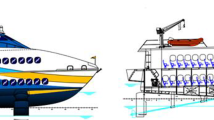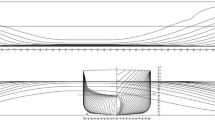Abstract
Retractable hydrofoils may enhance performances of seaplane during take-off and landing runs by lowering the speed when the hull is leaving or touching water surface. Hydrofoils are designed to complement airlift with additional hydrodynamic lift elevating the hull above the water at a speed lower than take-off speed; this minimizes slamming phenomenon on the hull, improving seakeeping capability of the seaplane, since water impacts are minimized compared to conventional configuration and, as a consequence, forces and accelerations on airframe, crew and passengers are reduced. This is of foremost importance on ultralight seaplanes, where wave forces acting on the relatively small aircraft mass provide high accelerations and significant roll, pitch and yaw forces that are higher on light aircraft compared to heavy seaplanes. As matter of facts, clear advantage of this configuration is the increase of sea state when a light seaplane can safely fly, providing additional useful days along the year. Important benefit is the improvement of seaplane performances during take-off and landing, reducing duration of the most critical flight phases, increasing overall safety and reducing pilot workload. Further benefits are envisioned, with optimization of wing, empennage and fuselage to minimize aero-drag and, as snow-ball effect, mission fuel consumption and energy power requirements. Life-cycle cost receives benefits too, since less water spray is ingested by engine and less water droplets impinge on fast revolving propeller, thus reducing expensive power plant maintenance cost over the entire service life.














Similar content being viewed by others
Notes
The term foiling refers to the condition in which the full displacement is sustained by the foils with no contribution from the hull.
References
Massy, H.S.: The seaplane and its development. Roy. United Serv. Inst. J. 57(429), 1452–1467 (1913)
Coombes, L.P., Perring, W.G.A.: The farnborough seaplane tank: the new equipment for seaplane research and development fully described. Aircr. Eng. Aerosp. Technol. 6(3), 63–66 (1934)
Pegram, R.: Schneider trophy seaplanes and flying boats: victors, vanquished and visions. Fonthill Media (2012)
Dewey, W.E.: Transonic Aerodynamic characteristics of a model of a proposed six-engine Hull-Type Seaplane designed for supersonic flight. NASA Langley Research Center (1960)
Handler, E.: The bureau of naval weapons hydrofoil seaplane. Nav. Eng. J. 75(2), 449–452 (1963)
Vagianos, N.J., Thurston, D.B.: Hydrofoil seaplane design. Thurston Aircraft Corporation, Report No. 6912S (1970). https://apps.dtic.mil/dtic/tr/fulltext/u2/873851.pdf
Gavazzi, P.: Volare Avanti: Storia degli aerei Piaggio. Proedi Editore, Milano (2000)
Barile, M., Amendola, G., Ingenito, V., Migliaccio, M., Lecce, L.: Development of a morphing wing concept for the Seagull A/C the next generation Marin-air vehicle. Italian Association of Aeronautics and Astronautics XXV International Congress 9-12 September 2019, Rome, Italy, (2019)
Western European Union: Wind and wave atlas of the mediterranean sea. Western European Union (2004)
Biancolini M.E., Cella U., Clarich A., Franchini F.: Multi-objective Optimization of A-Class Catamaran Foils Adopting a Geometric Parameterization Based on RBF Mesh Morphing. In: Andrés-Pérez E., González L., Periaux J., Gauger N., Quagliarella D., Giannakoglou K. (eds) Evolutionary and Deterministic Methods for Design Optimization and Control With Applications to Industrial and Societal Problems. Computational Methods in Applied Sciences, vol 49. Springer, Cham (2019). https://doi.org/10.1007/978-3-319-89890-2_30
Masri, J., Dala, L., Huard, B.: A review of the analytical methods used for seaplanes’ performance prediction. Aircraft Engineering and Aerospace Technology, Vol. 91 No. 6, pp. 820-833. https://doi.org/10.1108/AEAT-07-2018-0186
Hermann Schlichting: Boundary layer theory. McGraw-Hill (1979)
Menter, F.R.: Two-equation eddy-viscosity turbulence models for engineering applications. AIAA J. 32(8), 1598–1605 (1994)
https://www.flightglobal.com/india-looks-to-acquire-18-shinmaywa-us-2-amphibians/114377.article
Author information
Authors and Affiliations
Corresponding author
Additional information
Publisher's Note
Springer Nature remains neutral with regard to jurisdictional claims in published maps and institutional affiliations.
Rights and permissions
About this article
Cite this article
Maglione, A., Cella, U., Biancolini, M.E. et al. Innovative Approach for Use of Hydrofoils on Ultralight Seaplane. Aerotec. Missili Spaz. 100, 123–129 (2021). https://doi.org/10.1007/s42496-021-00078-2
Received:
Revised:
Accepted:
Published:
Issue Date:
DOI: https://doi.org/10.1007/s42496-021-00078-2




